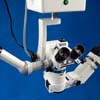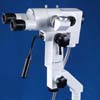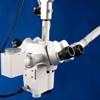The Role Of The Surgical Microscope In Eye Surgery
Eye surgery is usually done to remove a cataract, correct vision defects and even manage glaucoma. The parts of the eye being too small to view without the use of an ophthalmological instrument, the slit lamp microscope or surgical microscope is central to aiding eye surgeons in the correction of eye defects.The slit lamp microscope is a biological microscope instrument that uses a high-intensity light to illuminate the object being viewed. This light can be focused through a narrow slit to provide a three-dimensional or stereoscopic image of the eye. Used mainly to examine the anterior and posterior segments of the eye to check for abnormalities in the structure of the cornea or the retina, slit lamp microscopes are also used by ophthalmologists in performing ophthalmic surgery. Today, the normal ophthalmic surgical microscope is equipped with different objectives for a wider range of magnification as well as zoom capabilities to further aid in the success of eye surgery. Foot pedals are attached to the ophthalmological equipment so that the ophthalmologist can adjust the image magnification without having to use their hands.
To view the anterior segment of the eye under the slit lamp biological microscope, the ophthalmologist may have to apply a dye to the corner of the eye to be able to distinguish between the parts better. This dye would be slightly orange in color and can be washed away naturally with tears. Patients undergoing a slit lamp examination are advised to take off their contact lenses if they are wearing any because the dye stains lenses permanently. The patient would be asked to rest their chin on a stage attached onto the biological microscope so that head movements would be at a minimum while the ophthalmic examination is going on. Once this is done, the ophthalmologist would use dilating drops to examine the posterior segment of the eyes. These drops would open up the pupils to allow the lens of the slit lamp microscope to look at the back of the eye. Diluting drops might take up to 20 minutes to take effect. At some very rare cases, the chemical composition of the drops might trigger the increase of intraocular pressure, which will make itself known by nausea and pain in the eyeballs. But usually the worse effect of diluting drops would be sensitivity to light for several hours after the eye examination.
Using the slit lamp in surgery is particular helpful in viewing the thickness of the cornea. Since it’s impossible for the ophthalmologist to have a cross-section view of the eye, what they did in the past was to inject air into the front part of the eye and measure the space between the surface of the air bubble and the edge of the surgical blade. This space is the approximated measurement of the thickness of the cornea, which at best, was only a rough estimate. With a slit lamp surgical microscope, it’s quite possible to look at corneal thickness in a three dimensional image through the binocular eyepiece. Studies are also being done to further improve the surgical microscope by adding a video assisted system which will help the ophthalmologist in performing the surgery better.
Back to Articles
call toll-free:  or email
or email

 or email
or email
Categories
Categories
Dental
Dental Microscopes
Dental Microscopes
Ophthalmic
Ophthalmic Microscopes
Ophthalmic Microscopes
Gynecology
Gynecology Colposcopes
Gynecology Colposcopes




